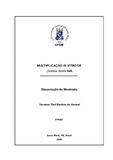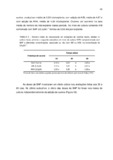| dc.creator | Amaral, Vanessa Fiad Martins do | |
| dc.date.accessioned | 2006-12-22 | |
| dc.date.available | 2006-12-22 | |
| dc.date.issued | 2006-02-24 | |
| dc.identifier.citation | AMARAL, Vanessa Fiad Martins do.In vitro multiplication of Cedrela fissilis Vell.. 2006. 79 f. Dissertação (Mestrado em Recursos Florestais e Engenharia Florestal) - Universidade Federal de Santa Maria, Santa Maria, 2006. | por |
| dc.identifier.uri | http://repositorio.ufsm.br/handle/1/8655 | |
| dc.description.abstract | This study had as objective to study the in vitro regeneration of cedar (Cedrela fissilis Vell.), a native tree of economic interest, belonging to Meliaceae family. For seeds desinfestation, different treatments with sodium hypochlorite in different concentration and immersion times were tested combined with differents culture mediums. To establish the nodal segments in vitro, benlate at 300 mg.l-1 and streptomicine sulphate at 10 mg.l-1 were added to the culture medium WPM reduced to ¾ of its salts concentration, isolated or not. After that, the hypocotyl segments from the 30 days in vitro cultured plants were used as explant in sprouts multiplication in culture mediums MS and WPM combined or not with the cytokinins BAP and KIN at 5μM.l-1 . It was also tested, in hypocotyl segments, the influence of BAP (0; 1,25; 2,5 and 5,0 μM.l-1) combined with the IBA or NAA (0,55μM.l- 1), in culture medium WPM during two subcultives. 60 days hypocotyl segments from cultive in BAP (0;1,25; 2,5 and 5,0 μM.l-1) were transferred to WPM medium added of only GA3 at 3μM.l-1 remaining during more than 30 days. Seeds desinfestated with sodium hypochlorite at 2% during 10 minutes showed a lower index of fungal contamination (8,7%) and the higher index of germination (80%), the mediums MS and WPM allowed the germination of 72,5%. The nodal segments from 3 years old plants showed an average index of bacterial contamination (13% 21 days after the inocultation) when cultivated in WPM culture medium added of benlate (300mg.l-1) plus streptomicine sulphate (10 mg.l-1) and survival index of 83%. The explants from the hypocotyl region showed average indexes of regeneration of 2,8 when cultivated in WPM medium supplemented with BAP at 5μM.l-1, on the other hand, in MS medium, the average tax of formation was 2,5 sprouts per explant. When tested in WPM culture medium, in different BAP concentrations, only at 30 days of cultive there was an interaction between the cytokinins doses and the presence of auxins IBA and NAA. BAP at 5μM showed explants with higher taxes of multiplication, regardless the auxins addition to the culture medium. In the following subcultives there was not an interaction between the concentrations and the effect of auxin presence, where the medium without auxin, associated to BAP at 5μM, promoted a higher average of sprouts per explant 2,29 (60 days). The average number of knots at 30 days of cultive was of 2,84 when evaluated the medium with ANA plus 2,5μM of BAP. At 60 days, the culture medium without the auxine promoted an average of 4,15 knots per explant, differing statistically from the mediums with auxin. At 90 days, the number of knots were 5,59 when BAP was used at 5μM plus IBA. The average length of the sprouts in the medium with NAA showed to be the more efficient (0,86 cm) at 30 days of cultive. At 60 days, the average length of the sprouts was of 0,95 and, at 90 days the average length of the sprouts was of 1,14. The formation of callus in the base of the explants happened when cytokinins were added to the medium, and the roots formation happened in the absence of these and in the presence of the auxin, generating complete plants. Explants exposed to GA3 at 60 days of cultive showed a partial reversion, showing an increase in formed roots and average length of the sprouts. | eng |
| dc.format | application/pdf | por |
| dc.language | por | por |
| dc.publisher | Universidade Federal de Santa Maria | por |
| dc.rights | Acesso Aberto | por |
| dc.subject | Cedrela fissilis | por |
| dc.subject | Cultura de tecidos | por |
| dc.subject | BAP | por |
| dc.subject | ANA | por |
| dc.subject | AIB | por |
| dc.subject | KIN | por |
| dc.subject | Cedrela fissilis | eng |
| dc.subject | Tissue culture | eng |
| dc.subject | NAA | eng |
| dc.subject | IBA | eng |
| dc.subject | KIN | eng |
| dc.title | Multiplicação in vitro de Cedrela fissilis Vell. | por |
| dc.title.alternative | In vitro multiplication of Cedrela fissilis Vell. | eng |
| dc.type | Dissertação | por |
| dc.description.resumo | O presente trabalho teve como objetivo o estudo da regeneração in vitro de cedro (Cedrela fissilis Vell.), uma árvore nativa de interesse econômico, pertencente à família Meliaceae. Para a desinfestação de sementes, foram testadas diferentes concentrações e tempos de imersão em
hipoclorito de sódio e para a germinação, diferentes meios de cultura. Para o estabelecimento in vitro de segmentos nodais, foram adicionados ao meio de cultura WPM, reduzido a ¾ de sua concentração original, benlate (300 mg.l-1) e sulfato de estreptomicina (10 mg.l-1). Após, segmentos do nó
cotiledonar advindos de plântulas germinadas in vitro com 30 dias de idade, foram utilizados para a multiplicação de brotações nos meios de cultura MS e WPM, em combinação ou não com 5μM.l-1 de BAP ou KIN . Foi testado também, a influência da citocinina BAP (0; 1,25; 2,5 e 5,0 μM.l-1)
combinada ou não com as auxinas AIB ou ANA (0,5μM.l-1) em meio de cultura WPM durante dois subcultivos. Os segmentos do nó cotiledonar com 60 dias de cultivo em meio WPM e BAP (0; 1,25; 2,5 e 5,0 μM.l-1) foram transferidos para meio WPM adicionado apenas de GA3 a 3μM.l-1 permanecendo por mais 30 dias. Os resultados demonstram que as sementes desinfestadas com hipoclorito de sódio a 2% durante 10 minutos apresentaram a menor taxa de contaminação por
fungos (8,7%) e a maior percentagem de germinação (80%), os meios MS e WPM proporcionaram percentagem de germinação de 72,5%. Os segmentos nodais de plantas de três anos de idade apresentaram uma taxa média de contaminação por bactérias de 13% após 21 dias de inoculação quando cultivados em meio de cultura WPM adicionado de benlate (300mg.l-1)mais sulfato de
estreptomicina (10 mg.l-1)e taxa de sobrevivência de 83%. Os explantes provenientes da região do nó cotiledonar apresentaram regeneração média de brotações de 2,8 quando cultivados em meio WPM suplementado com BAP a 5μM.l-1, enquanto que, no meio MS, a taxa média de brotações foi de 2,5 por explante. Quanto testados em meio de cultura WPM, em diferentes concentrações de BAP, apenas aos 30 dias de cultivo, houve interação entre as doses da citocinina e a presença das auxinas AIB e ANA. O BAP a 5μM apresentou explantes com maiores taxas de multiplicação de brotações
independente da adição das auxinas ao meio de cultura. Nos subcultivos subseqüentes, não houve interação entre as concentrações e o efeito da presença de auxina, em que o meio sem a presença desta, adicionado o BAP a 5μM, proporcionou a maior média de brotações por explante 2,29 (60 dias). O número médio de nós aos 30 dias de cultivo foi de 2,84 no meio contendo ANA mais 2,5 μM de BAP. Enquanto que, aos 60 dias, o meio de cultura sem auxina proporcionou uma média de 4,15 nós por explante, diferindo estatisticamente dos meios contendo auxina. Aos 90 dias de cultivo, o número de nós foi de 5,59 quando utilizado BAP a 5μM mais AIB ao meio de cultura. Quanto ao comprimento médio das brotações, o meio contendo ANA mostrou ser o mais eficiente (0,86 cm) aos 30 dias de cultivo. Aos 60 dias, o comprimento médio das brotações foi de 0,95 e, aos 90 dias o
comprimento médio de brotações foi de 1,14. A formação de calos na base dos explantes ocorreu quando foi adicionada citocinina ao meio, e a formação de raízes ocorreu na ausência desta e na presença de auxina, gerando plantas completas. Explantes expostos ao GA3 aos 60 dias de cultivo
mostraram parcial reversão, apresentando um aumento na percentagem de raízes formadas e comprimento médio de brotações. | por |
| dc.contributor.advisor1 | Franco, Elci Terezinha Henz | |
| dc.contributor.advisor1Lattes | http://lattes.cnpq.br/0872554252718309 | por |
| dc.contributor.referee1 | Paranhos, Juçara Terezinha | |
| dc.contributor.referee1Lattes | http://lattes.cnpq.br/1141490691821849 | por |
| dc.contributor.referee2 | Bisognin, Dilson Antônio | |
| dc.contributor.referee2Lattes | http://lattes.cnpq.br/7298261913496737 | por |
| dc.creator.Lattes | http://lattes.cnpq.br/5188453223372300 | por |
| dc.publisher.country | BR | por |
| dc.publisher.department | Recursos Florestais e Engenharia Florestal | por |
| dc.publisher.initials | UFSM | por |
| dc.publisher.program | Programa de Pós-Graduação em Engenharia Florestal | por |
| dc.subject.cnpq | CNPQ::CIENCIAS AGRARIAS::RECURSOS FLORESTAIS E ENGENHARIA FLORESTAL | por |



